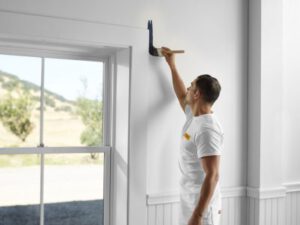Painter is important when you are remodeling or building a new house. They are able to help you create the look you want by applying new paints or repairing a scuffed-up ceiling. However, there are many mistakes that painters make when painting your home.
House painters typically use oil-based paint for their projects. This type of paint provides a hard finish and has excellent moisture resistance. Oil-based paint is perfect for exterior trim, cabinetry, and door casings. It also provides a higher sheen than most water-based paints.
Although some paints are still made with oil-based components, the federal government has tightened regulations on VOCs, or volatile organic compounds, in architectural paints. These volatile organic compounds are harmful to the environment and can cause headaches, nausea, and other adverse health effects.
As a result of these regulations, many professional painters have switched to water-based paints. Water-based paints are more durable and easier to work with. However, they may not dry completely, and do not provide the glossy, smooth finish of an oil-based product.
Another disadvantage of oil-based paint is that it must be treated as hazardous waste. It requires a solvent for cleanup, and it emits a strong odor.
Because of their high VOC content, oil-based paints require ventilation, so it is a good idea to keep windows open during application. Some oil-based products are not available in states with less stringent regulations.
While oil-based paint has been used for years, it is becoming harder to find. Oil-based paint is often referred to as alkyd or solvent-based paint. The paint is made from natural or synthetic oils and binders. Many paints are composed of linseed oil, which is a rust-inhibiting material.
When applying oil-based paint, you need to apply a primer first. Unlike latex-based paint, oil-based paint has a resin-based binder that is hard to scrub and clean. Therefore, you should use a different brush and cleaner to remove the old paint.
There are other advantages to using oil-based paints, including their ability to provide a heavy-duty coating that resists stains and scratches. Oil-based paints also have better resistance to low temperatures and the degenerative effects of water. They are also better at covering small imperfections.
One-coat coverage is another benefit of using oil-based paint. However, it is important to note that this type of paint is prone to cracking and yellowing.
Latex paint is one of the most popular choices for house painters. It can be used for a wide variety of surfaces, including wallpaper, ceilings, walls, trim, and even exterior siding. Aside from being easy to apply, latex paint is also easier to clean up after.
Compared to oil-based paint, it has a shorter drying time, a lower odor, and is less toxic. Moreover, it’s less likely to crack or flake.
While latex paint has its advantages, it’s not the best choice for painting rough or uneven surfaces. Also, it does not adhere well to glossy surfaces. On the other hand, it is very durable and resistant to fading and chalking.
The water-based nature of latex paint is also a plus. Because it is less harmful to the environment, it’s often preferred by homeowners. Plus, it’s safe for pets and children. If you don’t want to use latex paint, oil-based paint is a better option.
Oil-based paint is often more durable. It can withstand the wear and tear of high-traffic areas. However, it can be difficult to mix with latex. Therefore, it’s better to stick to one type of paint rather than use both.
In addition to being easier to use, latex paint is also cheaper. When you buy a can of latex, it’s recyclable. And it’s a lot more affordable than acrylic. Whether you’re doing a large project or simply redecorating your interior, good quality latex paint will last for a long time.
Both types of paint can be applied over previous latex coatings, but you need to make sure the surface is completely dry before applying any coats. You should also sand between coats if necessary. Using a paint extender can help you get a smooth brushmark-free finish.
Latex paint is also much cheaper than its oil-based cousins. It can be recycled and can be easily cleaned. But it does have its downsides, such as its tendency to chip. Moreover, it isn’t as water-resistant as other types of paint.